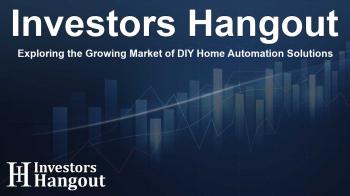Exploring the Growing Market of DIY Home Automation Solutions

Exciting Growth in DIY Home Automation
The market for DIY home automation is on a thrilling trajectory, reflecting a remarkable shift in consumers' approach to smart home technology. The latest insights reveal that the DIY Home Automation market was valued at USD 50.46 billion in recent years and has an ambitious projection to reach USD 508.78 billion by 2032, reflecting a compound annual growth rate (CAGR) of 29.28% from 2024 to 2032.
Transforming Homes: The Rise of DIY Solutions
The increase in DIY home automation solutions signifies a broader trend where consumers are eager to enhance the convenience and functionality of their living spaces without incurring the hefty costs associated with professional installations. With numerous devices available that require minimal setup, homeowners can easily design systems tailored to their needs. Products such as smart lighting, home security cameras, thermostats, and even voice-controlled devices have emerged as accessible and affordable options for everyone.
Affordability and Accessibility
In recent years, the U.S. market alone shows significant growth from USD 13.94 billion to an expected USD 123.91 billion by 2032, reflecting a CAGR of 24.47%. This transition is largely driven by the desire for cost-effective solutions, as homeowners seek ways to save on both initial setup and long-term utility bills through energy-efficient technologies. The expansion of e-commerce and direct sales models has also reduced prices, making DIY automation more attainable.
Market Leaders and Innovations
The landscape of DIY home automation features a variety of key players leading the market. Companies such as Nest Labs, Honeywell International, and Samsung Electronics dominate with innovative products ranging from smart thermostats to complete home automation systems. The introduction of integrated systems allows seamless operation and enhances user experience significantly.
Emerging Trends and Technologies
The advent of new technologies continually reshapes the DIY home automation industry. Enhanced interoperability between devices, driven by platforms like the Matter protocol, is encouraging higher adoption rates. Homeowners are increasingly interested in smart technologies that simplify daily tasks and improve energy efficiency. Moreover, the integration of AI and machine learning into home automation systems has opened doors for more proactive and adaptive solutions.
Drivers of Market Demand
Several factors contribute to the growing demand for DIY home automation. Security concerns remain paramount, leading consumers to invest in smart locks, cameras, and various security measures. Additionally, the health segment is increasingly prominent, particularly remote health monitoring systems that cater to older adults. These devices make essential care more manageable, enhancing the quality of life.
Technological Advancements and Consumer Behavior
The technological backbone of the industry, particularly network technologies, captured over half of the market share in recent years. With the expanding Internet of Things (IoT) framework and the blossoming field of 5G technology, the connectivity and speed of smart devices are improving, thereby making integration within homes more attractive than ever before.
Regional Insights and Future Prospects
North America stands at the forefront of the DIY home automation market, holding around 40% of total revenue. Factors such as high consumer demand and robust infrastructure provide a solid foundation for continued growth. Meanwhile, the Asia Pacific region is projected to be the fastest-growing market segment, driven by rapid urbanization, rising incomes, and extensive government initiatives promoting smart technologies.
Market Outlook
Looking ahead, the potential for DIY home automation is remarkable. As consumers become more tech-savvy and aware of the advantages of smart homes, the demand for comprehensive, user-friendly systems will continue to grow. In addition, advancements in software and applications are set to enhance functionality, user experience, and energy management. With these evolving trends, the DIY home automation landscape promises to remain dynamic and innovative into the next decade.
Frequently Asked Questions
What is the projected growth of the DIY home automation market?
The DIY home automation market is projected to grow from USD 50.46 billion to USD 508.78 billion by 2032, with a CAGR of 29.28% from 2024 to 2032.
What drives consumers to choose DIY home automation?
Consumers are increasingly opting for DIY home automation due to affordability, convenience, and the ability to customize their setups without professional installation costs.
Which products are trending in the DIY home automation market?
Trending products include smart lighting, security cameras, thermostats, and voice-controlled systems, offering smart home convenience to budget-conscious buyers.
How is technology impacting DIY home automation?
Technology enhances the DIY home automation market by improving device interoperability, connectivity, and energy efficiency through advancements like the Matter protocol and increased IoT integration.
What regions are leading in DIY home automation adoption?
North America currently leads the market, while the Asia Pacific region is expected to exhibit the fastest growth due to urbanization and rising disposable incomes.
About The Author
Contact Evelyn Baker privately here. Or send an email with ATTN: Evelyn Baker as the subject to contact@investorshangout.com.
About Investors Hangout
Investors Hangout is a leading online stock forum for financial discussion and learning, offering a wide range of free tools and resources. It draws in traders of all levels, who exchange market knowledge, investigate trading tactics, and keep an eye on industry developments in real time. Featuring financial articles, stock message boards, quotes, charts, company profiles, and live news updates. Through cooperative learning and a wealth of informational resources, it helps users from novices creating their first portfolios to experts honing their techniques. Join Investors Hangout today: https://investorshangout.com/
The content of this article is based on factual, publicly available information and does not represent legal, financial, or investment advice. Investors Hangout does not offer financial advice, and the author is not a licensed financial advisor. Consult a qualified advisor before making any financial or investment decisions based on this article. This article should not be considered advice to purchase, sell, or hold any securities or other investments. If any of the material provided here is inaccurate, please contact us for corrections.

